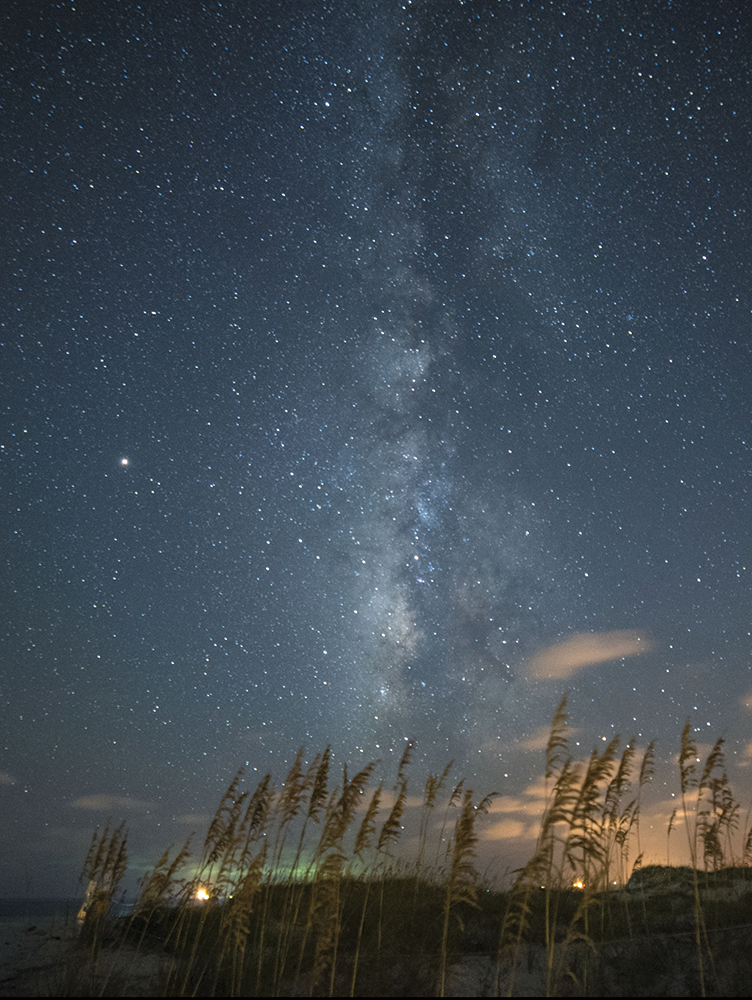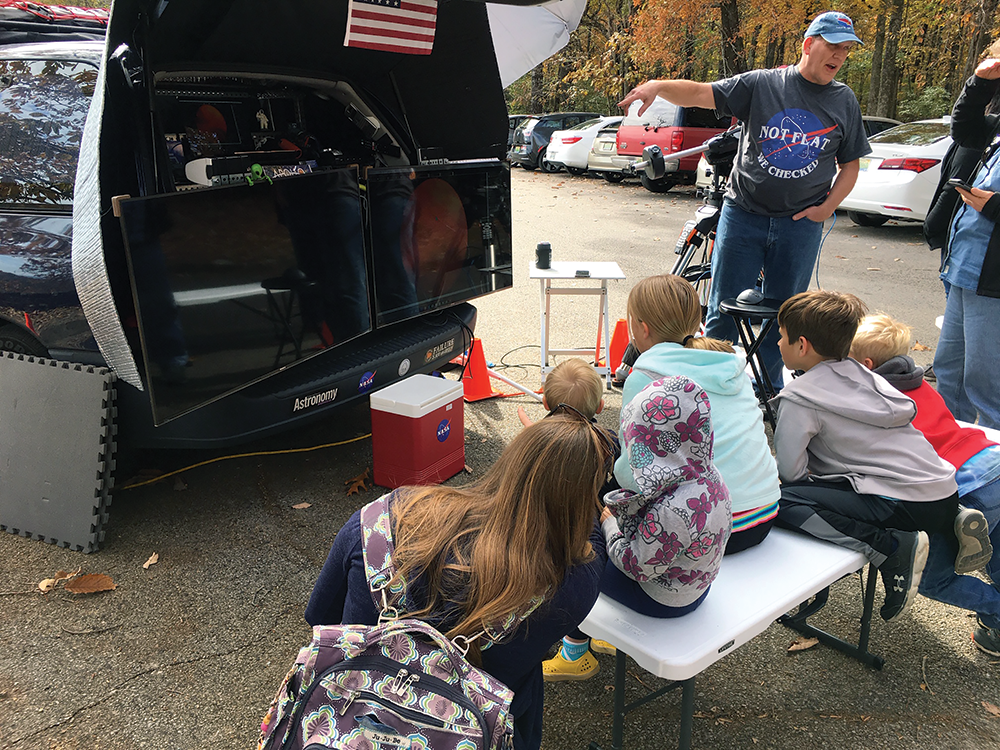By Katie Jackson
Looking for something to do this summer? Look up.
Whether viewing it from a blanket in the back yard or through a high-powered telescope, there’s as much to see in an Alabama sky as there are stars (and other celestial objects) in the heavens. Just be forewarned, looking up may keep you up at night.
Stargazing is one of humankind’s oldest activities, and is the basis for our oldest science, astronomy. Since ancient times, humans have looked to the skies for navigation, inspiration, edification and relaxation. And stargazing — or “skygazing,” which encompasses both day and night viewing opportunities — is a safe, free and soothing activity to help anyone, anywhere navigate these uncertain times.
Within the skygazing community are many amateur astronomers, people who don’t make their living as astronomers but have developed exceptional skills and knowledge, often focused on a particular branch of astronomy. Some are interested in as-yet undiscovered or hard-to-find celestial objects and events, such as fuzzy nebulae or planetary conjunctions.
Others are fascinated by the science and math of astronomy or are focused on photographing the cosmos. And, yes, some are looking for signs of extraterrestrial life.
All can and will share their knowledge and appreciation of the universe. They will not, however, interpret your horoscope.

Alabama’s undeveloped and rural areas, which are less affected by light pollution, can be good examples of “dark sky” locations ideal for nighttime sky viewing.
“People do confuse us with astrologists, which is how astronomy got started, so they are our distant cousins,” said long-time Birmingham Astronomical Society of Alabama member Fred Rains, “but we won’t tell anyone’s fortune.”
Instead, he and his fellow BAS members swap knowledge, stories and maybe a few exaggerations. “We’re just like a bunch of fishermen,” he laughed, though astronomers’ fish stories likely relate to the constellation Pisces.
What they really love to do is introduce new folks to skygazing, a pastime that can be enhanced with a telescope or binoculars but is equally gratifying without magnification. “All you really need are your eyes, a star chart and a clear sky,” Rains says.
Why a clear sky? Because clouds block the view from Earth to the sky, ruining many a skygazer’s best-laid plans, which is why astronomers wish one another “clear skies” instead of “have a good one.”
Dark skies are also important for nighttime viewing because the darker the sky, the more vivid its objects. Unfortunately, in many places light pollution is diluting the darkness, which adversely af- fects both recreational viewing and astronomical studies.
Undeveloped and rural areas, however, are less affected by light
pollution. “Alabama is a good dark sky place,” said Auburn Astronomical Society president Allen Screws, who noted there are a number of official “dark sky” sites in the state, including both public and private locales, many of them protected and managed by amateur astronomy groups and individuals.
Eyes toward the skies
But even if you’re standing under a streetlight, there are plenty of things to see in a night sky, and plenty of astronomy experts around to help you find them. One of the primary missions of amateur astronomy clubs and societies is to offer educational outreach to schools, civic and youth clubs and others in their communities. Staff members at the state’s numerous planetariums and observatories, those domed buildings focused on learning and teaching about the cosmos, are also there to help.
According to Dr. Mel Blake, associate professor of physics at the University of North Alabama in Florence and director of UNA’s recently renovated observatory and planetarium, “Astronomy is one of the most accessible sciences. And anything that gets people curious and learning about science is good for all sciences, not just astronomy.”

PHOTO BY WINSTON JERROD MCQUITERY
Skygazing 101 Tips
Though cooler months tend to offer the best skygazing weather, there’s much to see right now. Here are a few tips to get you started, and possibly keep you up past your bedtime.
Get a sky guide (paper, digital or an interactive mo- bile app) to help identify visible celestial objects. (Remember, they change with the seasons.)
Find a location with a good view of the sky and as far away from artificial lights as possible.
While the best viewing occurs on clear nights with the least amount of moonlight, don’t wait for perfect conditions.
Once outside, give your eyes time to adjust to the dark, which can take up to 30 minutes.
Get started by orienting on a bright, obvious object in the sky, such as Venus or the Big Dipper, then let your gaze wander.
You can find lists of local experts and facilities atwww.seasky.org or by searching web and social media sites.


In fact, astronomy is great tool for educators trying to introduce school-age children to science, technology, engineering and math (STEM) careers. Beth Bero, president of the Von Braun Astronomical Society in Huntsville, has used astronomy in her elementary school classrooms for years. She’s also
written curriculum to help other educators do the same, and her award-winning work has introduced many a youngster to the beauty and science of the cosmos.
But astronomy education isn’t just for kids. It’s for anyone who will stop and take a gander at the sky, which is why many of these groups throw some stellar parties — star parties that is. These events are held regularly at observatories, planetariums and public dark sky sites in the state, and also on city streets, parking decks and anywhere amateur astronomers can set up their telescopes and invite passersby to take a gander at the sky.
“The most fun thing to do is to show people Saturn for the first time,” says BAS president James Moore. “Without fail, you get a reaction, because people realize how special it is to look at objects like that.”
Seeing objects like those is what turned many an ordinary earthling into a sky-smitten astronomer.
Take Blake’s career for example, which got its start when he was a middle schooler in Newfoundland, Canada. “I liked school and space, but I was a terrible speller,” he says.
Walking home one evening after staying late at school to practice his spelling, Blake noticed a “really bright object in the west.”
Curious, he stopped in at the library where the librarian (her name was Mrs. Skinner) helped him find books on the sky and identify that bright object. “It was Venus,” he says. “I have been a big fan of public libraries ever since.”

Bero’s interest was sparked by her father, who taught her the constellations and showed her such wonders as Jupiter’s moons and Saturn’s rings through his own small telescope. Early in her teaching career in Florida, Bero had a chance to use telescopes at her school, which garnered her an award from NASA in 1988.
One evening while she was in Huntsville to accept the award, Bero met “two of the most important things in my life.” One was the VBAS observatory, built in 1956 under the direction of the famous rocket scientist Wernher von Braun. The other was her future husband. When the two married in 1990, Bero moved to Huntsville and immediately volunteered with the VBAS. Three decades later, she’s still enamored of both.
The stories of how astronomers, both amateurs and professionals, became skygazers are as varied as their interests, but they share one common experience. They all looked up. You can too, and here’s wishing you clear skies.




